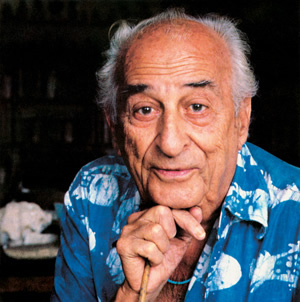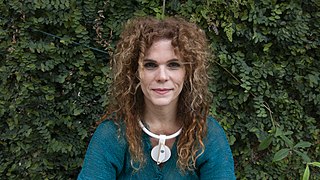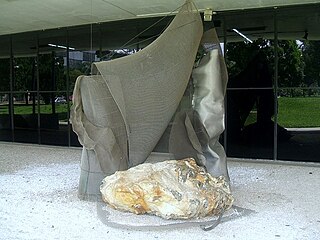Related Research Articles
Brígida Baltar was a Brazilian visual artist. Her work spanned across a wide range of mediums, including video, performance, installation, drawing, and sculpture. She was interested in capturing the ephemeral in her artwork.

Héctor Julio Páride Bernabó was an Argentine-Brazilian artist, researcher, writer, historian and journalist. His nickname and artistic name, Carybé, a type of piranha, comes from his time in the scouts. He died of heart failure after the meeting of a candomblé community's lay board of directors, the Cruz Santa Opô Afonjá Society, of which he was a member.

The Museu Nacional de Belas Artes is a national art museum located in the city of Rio de Janeiro, Brazil. The museum, officially established in 1937 by the initiative of education minister Gustavo Capanema, was inaugurated in 1938 by President Getúlio Vargas. The museum collection, on the other hand, takes its rise in the transfer of the Portuguese Court to Brazil in the early 19th century, when King John VI brought along with him part of the Portuguese Royal Collection. This art collection stayed in Brazil after the King's return to Europe and became the core collection of the National School of Fine Arts. When the museum was created in 1937, it became the heir not only the National School collection, but also of its headquarters, a 1908 eclectic style building projected by Spanish architect Adolfo Morales de los Ríos.

Gretta Sarfaty, born Alegre Sarfaty, is also known as Gretta Grzywacz and Greta Sarfaty Marchant, also simply as Gretta. is a painter, photographer and multimedia artist who earned international acclaim in the 1970s, from her artistic works related to Body art and Feminism. Born in Greece, in 1947, she moved with her family to São Paulo in 1954, being naturalized as Brazilian.

Fayga Perla Ostrower was a Polish-Brazilian engraver, painter, designer, illustrator, art theorist and university professor.

Alexandro Júlio de Oliveira Cerveny is a Brazilian artist, printmaker, sculptor, illustrator, and painter. His works evoke a fantastic universe and explore an iconography that articulates historical references, everyday culture, and personal memories.

Laura Lima is a contemporary Brazilian artist who lives and works in Rio de Janeiro. Since the 1990s, Lima has discussed in her works the matter of alive beings, among other topics. Her works can be found in the collections of institutions such as Bonniers Konsthall, Stockholm, Sweden; Inhotim Institute, Brumadinho, Brazil; MAM - Museum of Modern Art, São Paulo, Brazil; Migros Museum für Gegenwartskunst, Zurich, Switzerland; Pinacoteca of the State of São Paulo, Brazil; Itaú Cultural, São Paulo, Brazil; Pampulha Museum of Art, Belo Horizonte, Brazil; National Museum of Fine Arts, Rio de Janeiro, Brazil; Hammer Museum, Los Angeles, USA; MASP - Museum of Art of São Paulo, Brazil, among others.

Iole Antunes de Freitas is a Brazilian sculptor, engraver, and installation artist who works in the field of contemporary art. Freitas began her career in the 1970s, participating in a group of artists in Milan, Italy linked to Body art. She used photography. In the 1980s, she returned to Brazil, but abandoned the human body as mediator of her work, adopting the "sculpture body". The artist uses materials such as wire, canvas, steel, copper, stone, and water to create her works.
Gilvan Samico was a Brazilian painter, teacher and engraver of the Armorial Movement of graphic design.
Dudi Maia Rosa is a Brazilian artist.
Judith Lauand was a Brazilian painter and printmaker. She is considered a pioneer of the Brazilian modernist movement that started in the 1950s, and was the only female member of the concrete art movement based in São Paulo, the Grupo Ruptura.
Hermelindo Fiaminghi was a Brazilian painter, designer, graphic designer, lithographer, professor, and art critic, known for his geometric works and exploration of color.
Geraldo de Barros was a Brazilian painter and photographer who also worked in engraving, graphic arts, and industrial design. He was a leader of the concrete art movement in Brazil, co-founding Grupo Ruptura and was known for his trailblazing work in experimental abstract photography and modernism. According to The Guardian, De Barros was "one of the most influential Brazilian artists of the 20th century." De Barros is best known for his Fotoformas (1946-1952), a series of photographs that used multiple exposures, rotated images, and abstracted forms to capture a phenomenological experience of Brazil's exponential urbanization in the mid-twentieth century.

Edith Behring was a Brazilian artist and educator.
Vera Chaves Barcellos is a Brazilian artist and educator. She was featured in the Radical Women show at the Brooklyn Museum in 2018.

Wanda Pimentel was a Brazilian painter, based in Rio de Janeiro, Brazil. Her work is distinguished by "a precise, hard-edge quality encompassing geometric lines and smooth surfaces in pieces that often defy categorization as abstract or figurative. “My studio is in my bedroom,” Pimentel said in an interview. “Everything has to be very neat. .. I work alone. I think my issues are the issues of our time: the lack of perspective for people, their alienation. The saddest thing is for people to be dominated by things.”
Martha Araújo in Maceió, Brazil is a Brazilian sculptor and performance artist. She lives and works in Maceió the capital of Alagoas in Brazil. The style of her work was performance and sculpture art. She also explored her body with her performances. Her art emerged at the end of a military dictatorship that lasted from 1964 to 1985. She used their experiences during the dictatorship in her artwork to show how they felt trapped. Using textiles Araújo demonstrates the limit of the body through the play between repression and freedom. However, sculptures and performances were not her only interest she has also explored photography and video.
Mariannita Luzzati is a Brazilian visual artist from São Paulo, recognized for her extensive study of landscapes.

Marcela Cantuária is a Brazilian visual artist working primarily with paintings. Cantuária's work revolves around contemporary historical paintings produced in small and large formats. Recurring themes in her work are social movements, political history, feminisms, and environmental causes in Latin America.
Maria Lídia dos Santos Magliani was a Brazilian painter, designer, engraver, illustrator, costume designer and set designer..
References
- ↑ Instituto Arte na Escola (2006). O lirismo de Renina Katz (PDF). São Paulo: Instituto Arte na Escola. ISBN 8577620239.
- ↑ Abramo, Radhá (2003-12-01). "Renina Katz e sua arte". Estudos Avançados. 17 (49): 287–302. doi: 10.1590/S0103-40142003000300017 . ISSN 0103-4014.
- ↑ "Renina Katz Pedreira". Currículo Lattes. 1999. Retrieved April 18, 2017.
- 1 2 3 Motta, Gloria Cristina (2007). Arte em papel : o trabalho gráfico de Renina Katz (PDF). São Paulo: Faculdade Santa Marcelina.
- ↑ Silva, Regiane Aparecida Caire da (2012). "Espaço da criação de Renina Katz: o atelier coletivo" (PDF). Congresso Internacional da Associação de Pesquisadores Em Crítica Genética. X: 763–770.
- ↑ Katz, Renina (1997). Renina Katz. São Paulo: Edusp. ISBN 9788531403644.
- ↑ Interativa, Hous Mídia. "Pinacoteca – Renina Katz: Aquarelas". pinacoteca.org.br (in Brazilian Portuguese). Retrieved 2017-04-18.
- ↑ Aquarela: Renina Katz. São Paulo: Imprensa Oficial, Pinacoteca do Estado de São Paulo. 2011. ISBN 9788570609168.
- ↑ "Exposição". AGÊNCIA FAPESP (in Portuguese). Retrieved 2017-04-18.